This is your complete guide to Big Bend primitive camping, in a National Park full of adventure, rugged beauty, solitude, and spectacular starry skies beyond anything you've ever imagined or seen.
A beautiful, rugged, and unforgiving place, Big Bend camping is some of the best camping known to man. With over 801,000 acres, there's plenty of room for dispersed camping in Big Bend National Park.
While the park is quite rugged and desolate in some places, we found it to be a beautiful paradise away from the rat race of life. And while Big Bend is a fairly popular spring break destination, I'd still add it to my list of amazing spring break road trip ideas.
The only thing is, per Lockcuff family habit, we really didn't do a whole lot of planning before we went. I take that back… I did make sure to pack our passports because we planned to visit Boquillas, Mexico, while there.
So on the way to this southern point in Texas, I started looking for the best primitive roadside campsites Big Bend has to offer. I quickly found out we really should've done our research beforehand.
Table of Contents
- Things to Know about Big Bend Primitive Camping
- What Big Bend Camping Is Really Like
- Primitive Roadside Campsites in Big Bend
- What's the Best Time of Year to Visit Big Bend?
- Can You Bring Pets to Big Bend?
- Video of Our Camping Adventure at Robbers Roost Big Bend
- More State and National Park Camping Adventures
Things to Know about Big Bend Primitive Camping
While Big Bend does have 3 developed campgrounds, backcountry camping in primitive roadside campsites was our first choice. Since we visited in May when it's extremely hot (true Lockcuff fashion), we had no problem reserving one of the Big Bend National Park campsites.

Which brings me to my next point… Big Bend National Park camping reservations, in person, are a must. You HAVE to reserve your site and purchase a backcountry permit in person during visitor center hours, up to 24 hours in advance. It's not like your typical dispersed camping experience where you just go out and pick a site; you have to actually pick a site when you get your permit.
So, take it from me… This means even if you arrive at 5:15, and the visitor center closes at 5, you're out of luck until the next day. Also, cooler times of the year are when campsites really fill up; so you want to arrive early on to reserve a site.

The park has links to each campsite with photos. It was enough for us to just read descriptions, look through photos, kinda research the roads campsites are on, and pick a site that resonated with us.
Looking for more camping options in the USA? Check out how we find the best free places to camp.
What Big Bend Camping Is Really Like
It wasn't hard for us to pick a site. We knew we wanted solitude and a beautiful view.
Backcountry camping in Big Bend is available for backpackers. Dispersed or primitive roadside campsites are available on what they call “improved dirt roads” and “primitive dirt roads.” Primitive dirt roads require a high-clearance 4-wheel-drive vehicle. The road may get quite rocky, even sandy; and rain can make them impassable.

Of course, we decided on a primitive dirt roadside site, and we set off for Glenn Springs Road, which eventually comes to Juniper Canyon Road. Just to give you an idea of how long it took us to get to our site… From the paved road, we had about a little over an hour's ride on dirt road out to our campsite at Robbers Roost Big Bend.
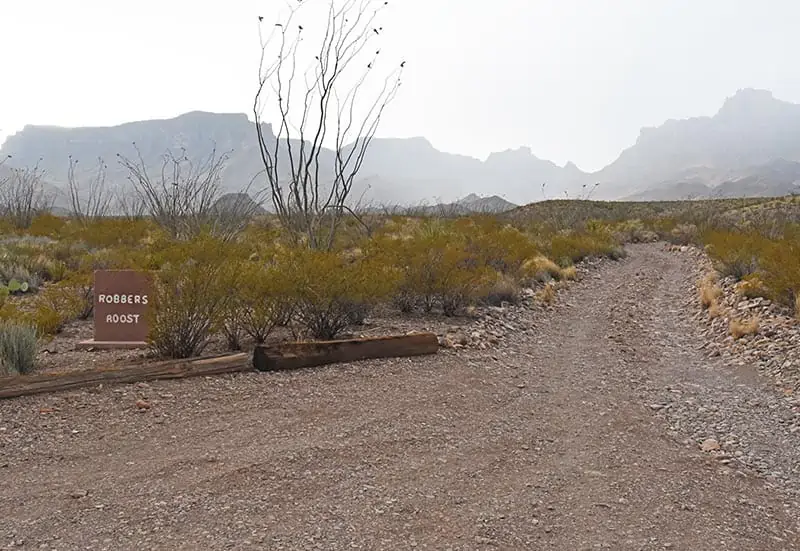
While it was a really long, really bumpy ride, the views were worth every single jolt. Of course, a thunderstorm hit on our first night out; but as that thunderstorm passed, we were hit with the most beautiful sunset over the mountains and a very surreal lighting like I'd never seen in my life.
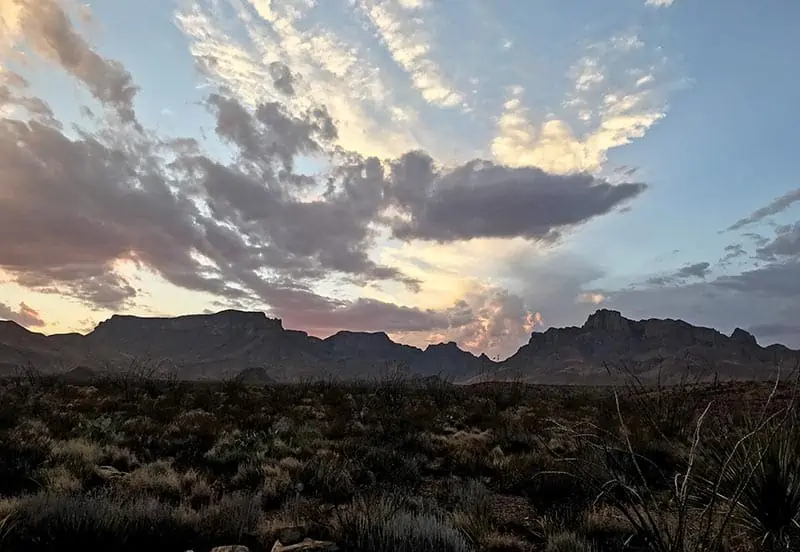
It was so surreal and with storms all around us, it were as if God cleared the clouds over our tent and allowed us a glimpse of His majesty. I've never experienced anything so beautiful in all my life.
Primitive Roadside Campsites in Big Bend
Robber's Roost is way out in the desert, with no one else around for miles. However, the site is really well developed with adequate parking, enough room for 3 tents, and a bear box to store food and anything else with a scent.
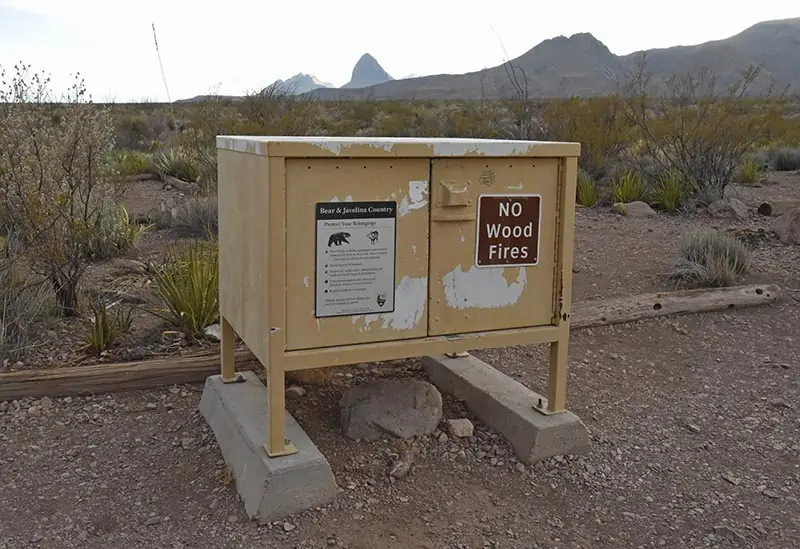
It provides amazing views of the Chisos Mountains, beautiful sunrise mornings, gorgeous sunset nights, colorful views of the Texas and Mexico desert, a stargazer's paradise, amazing sleep, and peaceful desert sounds in those early morning hours.
Every part of me longs to be back in that beautiful desert atmosphere.
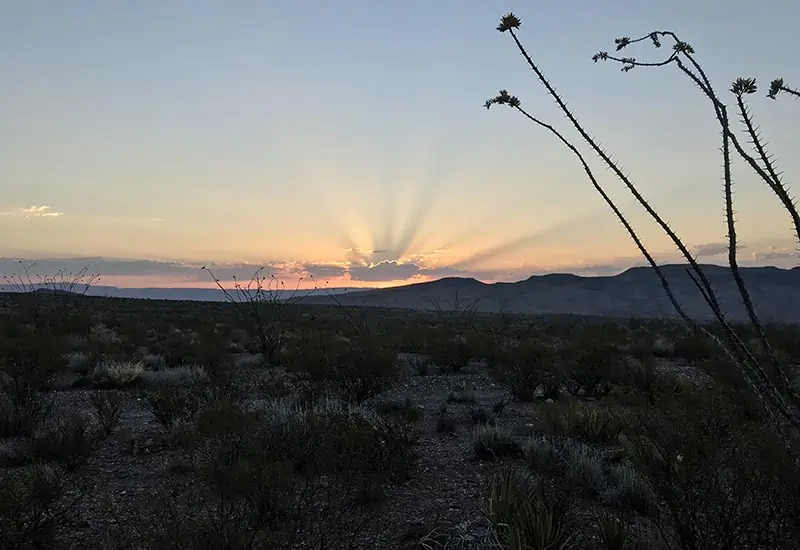
Can I Boondock or Camp in a Tent?
While boondocking isn't allowed in Big Bend, per park rules, roadside camping (with a permit) is allowed, and you can camp in your car or in a tent.
Big Bend offers 64 campsites on backcountry roads, most of them requiring high-clearance 4WD vehicles to reach them. Only a few of these sites can accommodate large RV's or camping trailers.
Each campsite has rules regarding vehicle length and capacity limits.
How to Reserve or Book a Big Bend Campsite
Online reservations are available online, up to 6 months in advance, for the 34 most popular campsites thru recreation.gov.
Reservations for the remaining 30 primitive roadside campsites can only be attained in person at the Panther Junction Visitor Center, daily from 8:30am to 5:00pm, and the Chisos Basin Visitor Center, daily from 8:30am to 4:00pm. Reservations must now be made 24 hours in advance of your first night's stay.
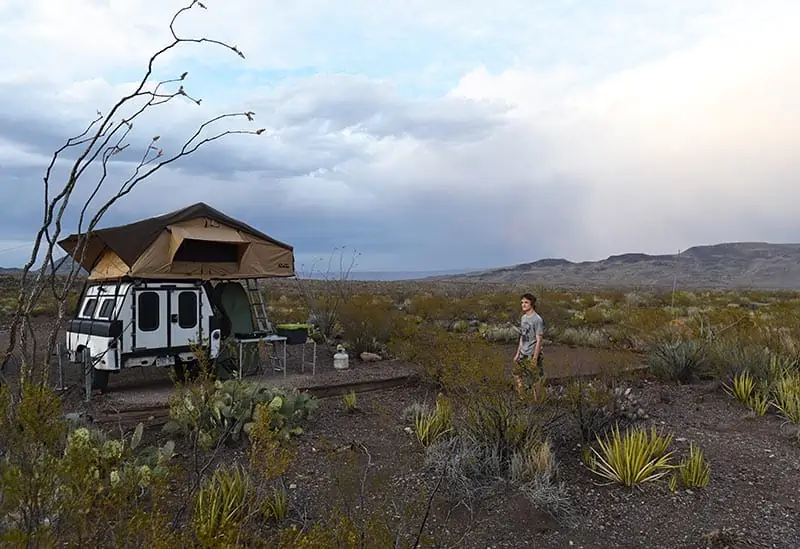
Before you head out, follow park regulations and get the required permit. Even though the permit isn't used to check on your safety, it allows rangers to talk with you, to get an idea of what sites will work for the type of vehicle you're driving, and make sure you know what you're getting yourself into, as well as warn you of the dangers.
They use the permits to track how many people use the primitive campsites, as well. And if you get caught without a permit? Not good.
Permits are only $12, and when you get yours, you can extend it out as long as 14 days.
Safety Tips for Big Bend Backcountry Camping
I wish we had a picture of the park sign we saw that read something like, “Please call your family and tell them you don't have cell phone service so they're not calling and reporting you missing.” Apparently, this happens a lot at Big Bend.
In all seriousness, it can be a very desolate place, and we learned a few lessons while trekking Big Bend even for the short time we were there this trip.
Here are a few safety tips, as well as tips for how to prepare for your Big Bend adventure…
- Tell people when and where you are going and plan on checking in, so they can report you missing if they don't hear from you; otherwise, the rangers will not know to look for you unless someone calls. Certain visitor centers have Wi-Fi, and there is cell service in some areas of the park, just likely not where you'll be camping. Stay in touch with your loved ones.
- Stay connected by carrying a radio so you can attempt to call someone if you need help.
- Carry at least a gallon of water per person, per day, for however long you'll be there, extra if you plan to use a portable shower for camping. Even if you plan to drive out the next day, carry extra because you never know what will happen, and you need water in order to survive. We consistently reached over 100 degree temps while there.
- Carry extra fuel. Gas stations are few and far between.
- Carry a map of the park with you at all times.
- Carry plenty of spare tires. We have 4. Even the ranger mentioned this to Dan; when Dan said we had 4, he said, “You've been down that road, huh?” Yes, we have, 10,000 feet up on a mountainside in Colorado in the dark, and it was not fun.
- Wear sunscreen. Even if you don't plan to be out in the sun long, wear it anyway. Also, wear proper clothing and shoes, especially shoes. There are rattlesnakes, scorpions, etc. Protect yourself and your little ones. Also, a hat goes a long way for shade, because there will be no shade, no shade at all, besides the occasional rock or boulder.
- Plan strenuous activities, like hiking in Santa Elena Canyon and other places, for early in the mornings or in the evenings when it's cooler; be sure to pack a good hiking carrier for little ones.
- Cactus is everywhere; it is a desert environment. While it's beautiful, it can also be quite attractive to little ones. Zeke found out the hard way that cactus hurts. Watch your kids closely, especially if you're in the middle of nowhere and a long way from cell service or help.
- Pack along a first aid kit.
- Stay low during a thunderstorm. Also, keep things tied down well. Keep all loose items stored when you're not at the campsite; strong winds can come up quickly in the desert.
- Campfires are banned. Even charcoal grills were not allowed while we were there. It's so dry, and all it takes is one spark.
- Keep food put away and closed up; bear boxes are provided because bears and javelinas are pretty prevalent in the park.
- Plan for the most beautiful starry nights you've ever seen in your life. Whether it's camera equipment you want to bring along to capture those night time images, or a map of the constellations, make sure you're prepared for night time skies in Big Bend.
- Pack it in, pack it out, including all trash. Leave no trace.
Use our camping checklist to help you pack what you need on your next camping adventure! And get the inside scoop on what it's like to go dispersed camping in a roof top tent vs. ground tent.
Where Do I Go for Supplies?
Gas is available at Panther Junction and Rio Grande Village. Diesel and limited groceries are also available at Panther Junction; and you can find propane at Rio Grande Village.
As for more supplies, you can find convenience stores at Rio Grande Village, the Chisos Basin, and at Castolon. They carry basic supplies like camping supplies, some groceries, and souvenirs too.

What's the Best Time of Year to Visit Big Bend?
It really depends on the reason for your visit. For example, if you're floating the river, you may want to visit in the summer months when the weather is hot hot hot.
If it's hiking and land adventure you're after, fall, winter, or early spring may be a good time. March can be crowded with spring break travelers, but the temperatures are just about right with warmth thru the day and cooler temps at night. Early spring also brings wildflowers to the park, so that is something to think about when planning your trip.
Keep in mind winter in the park brings freezing temps at night; and holidays can get quite crowded, about like spring break.
We can't wait to go camping in Big Bend National Park again, likely in the cooler weather of spring or fall. We fell in love with this beautiful, wild, rugged park and everything it has to offer.
It's one of those national parks you can spend days and weeks exploring and still not see everything there is to see. Next time maybe we'll go kayaking on the Rio Grande.
If it's not camping you want but lodging instead, Park Ranger John has all the details on Big Bend Lodging.
Can You Bring Pets to Big Bend?
Big Bend has a lot of rules and regulations around pets in the park. While they can come in the park, they can't be on any trails; in fact, they can only go where your car can go.
There are no kennel services in the park either. So it stands to reason that it's probably better not to bring pets into the park, unless you're camping in a campground and they'd be safe to stay in the camper.
Video of our Camping Adventure at Robbers Roost Big Bend
More State and National Park Camping Adventures:
- Roadside camping on the Rita Blanca National Grassland is a must for every stargazer.
- Cosby Campground in Great Smoky Mountains National Park is a park campground, but the sites are some of the most beautiful we've seen, with lots of room for solitude, if that's what you're after.
- Ozark National Forest camping in Arkansas lives amongst some of our favorite primitive places to camp.
- If you've never gone camping at Petit Jean State Park, you're in for a real adventure.
I always appreciate your feedback. Be sure to leave a comment, and follow me on Pinterest, Facebook, Instagram, and YouTube. You can subscribe to my email list too.
Have you gone camping in Big Bend National Park? Are you planning a trip? Let us know in the comments!








This is amazing. I have heard that Big Bend is vast, but when I see your pictures from your dispensed camping site it really shows how remote it is. Love that solitude. Excellent safety tips, which emphasize the importance of being prepared and using extreme caution. Thanks for sharing! :)
Thank you, Carl! We are planning another trip back because there’s just so much more to explore. It was very remote and very peaceful.
The place look amazing and camping is so much fun!
Cristina, Big Bend is so amazing! I agree, camping is a LOT of fun!